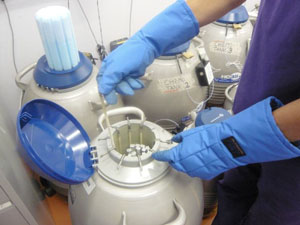Embryo Freezing (Cryopreservation)
What is embryo cryopreservation?
By cryopreservation, we understand the preservation of embryos that are formed during the in vitro fertilization process at very low temperatures (cryo). Cryopreservation is an alternative that has further increased the chances of successful pregnancy after a single IVF cycle. The first baby born after being frozen as an embryo was born in 1984.
Freezing can be done through either slow freezing or rapid freezing.
How is slow cryopreservation done?
Good quality embryos that are not used during the IVF procedure can be cryopreserved (frozen, conserved) and used at a later time if the couple wishes. These embryos are mixed with special mediums called cryoprotectants. Together with the medium, the embryos are placed in special tubes which are then stored inside a machine called a freezer.

This machine is computer programmed to slowly lower the temperature at a rate of 0.3 degrees to a temperature of 79 degrees below zero. After this, the tubes are stored in a container that contains liquid nitrogen at a temperature of minus 196 degrees Celsius.
How long can frozen embryos be stored?
As long as they are stored in liquid nitrogen at – 196 degrees Celsius, the embryos will be alive. The only theoretical damage is the loss that is caused by ice crystallization. Different countries have different laws that regulate the time during which the embryos can be stored frozen.
What are the advantages of freezing embryos?
- It allows maximizing the chances of pregnancy within the same IVF procedure and avoids "wasting" normal, living embryos that have "exceeded".
- In cases of ovarian hyperstimulation, the transfer of embryos can be canceled; the embryos can be frozen and transferred later when the hyperstimulation has passed.
- In cases where the endometrium does not seem suitable for implantation, the embryos can be frozen and transferred later when the endometrium is more suitable for implantation.
- In cases of cancer, the embryos can be frozen before chemotherapy or radiotherapy and transferred at a later time of remission.
What is the survival rate of embryos after freezing and thawing?
In a modern In Vitro Fertilization center, we always have a survival rate that reaches 75-80%. The 20% loss is due to the freezing and thawing process, which constitute a physical stress that not all embryos overcome. In modest centers, this loss is much higher.
What is the procedure for transferring frozen embryos?
Frozen embryos, after thawing, can be transferred in a natural cycle or in a stimulated cycle. Both methods have equal chances of success.
Vitrification (rapid freezing)
Vitrification is an ultra-rapid freezing procedure. Vitrification is the solidification of the solution in a “glassy” ice state. The vitrification of water inside cells can be achieved by increasing the rate of freezing. The use of high concentrations of cryoprotectant helps in achieving a very high viscosity during cooling. Vitrification is a technique that is used increasingly more than slow freezing.
When can embryos be frozen?
Embryos can be frozen at the stage when they are 2 to 8 cells, as well as at the blastocyst stage (day 5 of life). The main goal is to preserve additional possibilities for pregnancy in an IVF cycle.